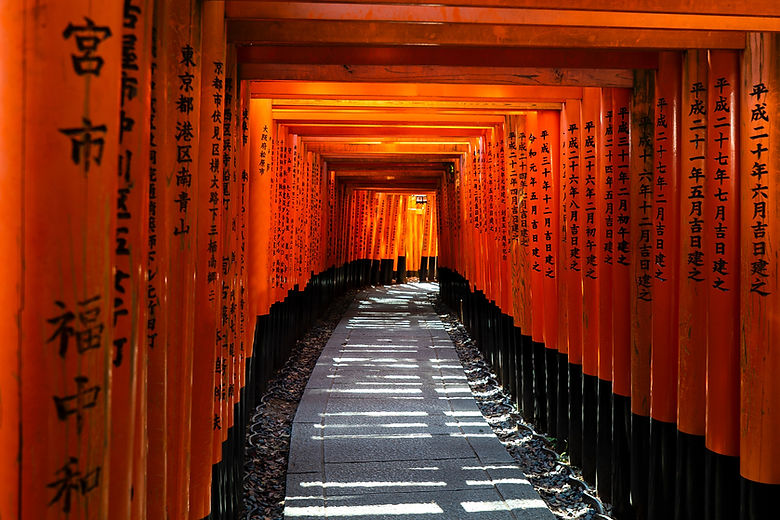
PLANNING




WHY DID I CHOOSE JAPANESE HISTORY?
As a chinese Singaporean, whom has never been to Japan save for a short layover in Haneda Airport on a flight to Los Angeles several years ago, It surprises many people when they discover I have a great passion for studying Japanese history.
The first response I get is "Wow, that's cool", the second and most relevant to our discussion is "Why"?
My usual reply is, Why Not?
Japan has a storied history going back thousands of years, multiple civilisations have called the Japanese islands their home, cultivated its lands, built cities, fought wars and engaged in cultural exchange and traded amongst themselves. As a result Japan has a unique culture which was influenced in its early stages by China, but was able to mature and bloom into its own unique form over centuries of isolation later as opposed to the Korean peninsula whose kingdoms were firmly within the Chinese sphere of influence and was in fact a vassal state of later Chinese dynasties as the kingdom of Joseon.
Through my research for this book, I learned that Japan defied the expectations of outsiders and through its own efforts grew strong enough to challenge countries and empires arguably stronger or in better positions than they were, and yet still come out on top.

_by_Shunsai_Toshimasa_1889.jpg)
my interest in history
i have always had an interest in history going back to my days in Secondary School, although back in those days I was more interested in learning about classical civilisations like Rome or western European civilisations during the medieval period.
Part of my interest in pre-modern Japanese history is the similarities I noticed between the warrior classes of European civilisation and the Japanese, and the caste system/social hierarchy of both when I first started reading.
But what really got me started was Shinto mythology. Shinto is Japan's indigenous religion and it has its own fascinating creation story of two gods Izanagi and Izanami being responsible for creating the Japanese Islands and giving the world form, as well as birthing other gods. A sad part of the story is when Izanami dies from giving birth to Kagutsuchi the god of fire and Izanagi is so angry he cuts up Kagutsuchi into eight pieces and later tries to rescue Izanami by travelling to Yomi (The underworld), but ends up fleeing when he sees what has become of Izanami.
Izanagi goes on to create three very important deities after his escape from Yomi who will be important figures in the mythical history of Japan. Amaterasu the sun goddess, Tsukuyomi the moon god, and Susanoo the god of storms.
The actions of these kami in ancient texts like the Kojiki serve an important purpose, such as explaining how the world works (why day and night are seperate) and even legitimising the very right of the Emperor of Japan to rule over the land.
Reading the tales of Japanese mythology and how it blends into history is what really piqued my interest and got me started on my hobby to discover more of Japanese history and is largely why I decided to write this book in the first place.
Japan standing up to larger powers
I mentioned earlier that in the course of my research to write this book, I learned that Japan was able to go toe to toe which much larger countries because of the industrialisation it underwent during the Meiji Period.
Let's see some examples of this below.
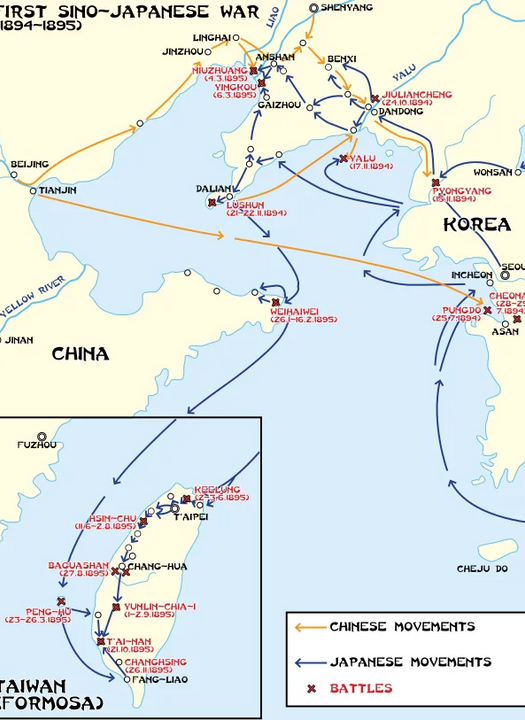
First Sino-Japanese War
This war began in 1894 and ended in 1895, it was fought between the Qing Dynasty (China) and the Empire of Japan. It's conclusion, with the signing of the Treaty of Shimonoseki was arguably a watershed moment for the Empire of Japan and all of East Asia. In short, China lost the war, and ceded the islands of Taiwan, the Pescadores, the Liaodong peninsula, and paid 200 million Kuping taels (7.5 million kg) of silver to Japan, and recognised Korea as an independent state. (Yamauchi & Hosoya, 2019)
I will be writing about this war in my book eventually, (stay tuned for updates) but here on the website, I want to share my reaction to reading about this in one of the books I found in the TP Library and used as a source to write my book.
The Qing Dynasty, which ruled over what was supposed to be the strongest country, the touchstone of civilisation itself, was forced to agree to such humiliating terms by a country they called 小日本 meaning "small Japan".
When I learned about this, I could not help but let out a small chuckle, after all, China simply got their just desserts with the outcome of this war. Being defeated in a war fair and square by a country they had labelled small, as a derogatory and racist insult, proved that by this point in time, these collection of islands were far more well-developed, advanced and stronger than the Big and "so-called" most civilised state in the world. It was truly a David vs Goliath moment, and Japan deserved to win.
Unfortunately, the subsequent Triple Intervention by Russia, Germany and France would force Japan to withdraw its troops from the Liaodong Peninsula in exchange for a token sum payment of 30 million kuping taels of silver, all so that Russia could send its own troops to occupy the peninsula and Port Arthur.

russo-japanese war
This war took place between 1904 and 1905 between the Russian Empire and the Empire of Japan. It marked the first instance in which a European power was defeated by an Asian power.
The outcome of the Triple Intervention mentioned above was actually partly responsible for this conflict, as Japan grew increasingly concerned and felt threatened by Russian expansion into Asia.
After the Liaodong peninsula fell under de-facto Russian control, Japan and Russia became locked in a cold war for influence over Korea and Manchuria, and a series of failed negotiations where Russia refused to accept Japanese interests in Korea led to the outbreak of war.
Again, more details about this war will be covered in the book in the near future, but the war was basically won at sea with key decisive battles like the Battles of Port Arthur and Tsushima and Russia's enormous size and poor geography would prove to be its own downfall as their inadequate far east forces were defeated at sea, and reinforcements from the Baltic arrived weakened and served as easy pickings for the Japanese.
By this point I began to notice a theme in the rise of Japan as a world power in the Meiji Period. They were defeating countries significantly larger than they were, first China and now Russia. In both instances the press and media in foreign countries expected the other side to be victorious, however Japan proved them wrong both times.
This is when I came up with the current title of this book, The Sleeping Giant of Asia.
The Sleeping Giant of Asia
At this point dear reader, If you are a history buff or are interested in regional geopolitics, you might be slightly confused, it's probably because you know the term, 'Sleeping Giant', especially in the geographical context of Asia is almost always used to refer to China, especially the period after capitalist reforms were introduced beginning with Deng Xiaoping and his "Deng Xiaoping thought".
So you may be wondering why I have chosen to call Japan a Sleeping Giant, in fact, the true Sleeping Giant of Asia. The simple answer is because it woke up first, way before China did, and it's footsteps did in fact shake all of Asia.
In the book you will learn about the 200 year period of isolation Japan went through where it closed itself off from most of the world. I think of this as the period of slumber where the giant rested, the population grew and the culture matured and flourished, but the technology stagnated and fell behind the rest of the world.
I see the succeeding Meiji - Taisho Periods as the time in which Japan woke up.
After just a few decades of industrialisation, it became a 'Giant' by catching up to the most advanced civilisations in the world, which were the empires of Europe and the United States and it demonstrated its newfound strength by defeating both China and a European Empire in the Meiji Period, and in the succeeding Taisho Period, found great success fighting World War 1 on the side of the Allies and conquering German possessions in Micronesia and China.
And of course you know what happened after this, in the early Showa Period, the Giant eventually bit off more than it could chew in World War 2 and lost.
But immediately following the war, the economy was on track to recovery.
Starting with loans and financial aid provided by US, Japan rebuilt its cities and infrastructure better than before, and its economy went on a several decade run in which they expanded their industrial production capacity, exported aggressively, and developed a large domestic consumer market.
Subsequently, the economy grew too quickly, it began to form a large speculative bubble from 1986, during this period, prices for real estate and stocks grew at unsustainable rates fueled by easy access to credit, this bubble would burst in 1992 and the Japanese economy underwent a period known as the 'Lost Decades' which it is arguably presently still in. I think of the lost decades as the Giant going back to sleep.
However if you have been following news about the Japanese economy recently, you would know that earlier this year in February 2024, the Nikkei 225, Japan's main stock index ended the trading day, closing at 39,098.68.
This beat the all time record of 38,915.87 set on 29 December 1989 which was the peak of the Asset Bubble, indicating that the Japanese stock market has finally recovered. I like to think of this as the part where the Giant is once again waking up, and hopefully this time the shaking will come in the form of new Japanese products, innovations, and technology changing the entire world, and Japan rising to once again take its place as the second largest economy in the world, possibly even going further and overtaking the US itself.
All of this will be covered in the completed book once it is finished. But in regards to whether Japan shoots back up from fourth place to second in GDP and manages to surpass China to be the second largest economy, only time will tell. But I personally am hoping for it.

What is this?
Before we continue further, allow me to explain the meaning behind this visual i created as a background image which you may see around this website.





What is this?
The astute among you will realise the last image is the flag of Japan, but what about the first four? Well from left to right these images represent, The Mon (紋) "heraldic crest" of the (1) Oda Clan, (2) the Toyotomi Clan, and the (3) Tokugawa Clan. After the Tokugawa Clan is the (4) Imperial seal of Japan, the Chrysanthemum Seal, and of course the last one is the (5) current flag of Japan.
Basically this image represents Japan through the ages. From the Azuchi-Momoyama Period (1), (2) to the Edo Period (3), to the Meiji, Taisho and early Showa Periods (4), to where it is today (5).

HOW I STARTED?
I began my project by setting some goals for my project. Because my project was to write a book, i wanted to use more authoritative sources such as books, academic journals or government sources as opposed to blogposts or news articles.
I used the 5W 1H framework to set these goals
Who

I settled on my target audience being Singaporean students studying in Temasek Polytechnic.
What

I wanted to achieve a deeper understanding of Japanese history centering on economics because this is most relevant to my ideal career. My deliverable would be a book with a length ranging between 20,000 - 50,000 words.
When
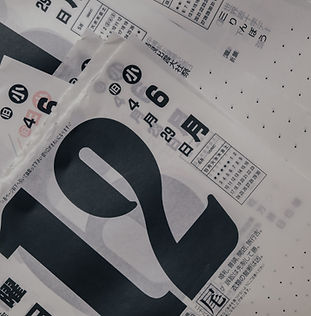
I aimed to finish the book entirely within 10 weeks, and the other deliverables within 16 weeks so i would have 1 week as a buffer just in case.
Where

I aimed to share it on a website, which is the site you are presently viewing and hopefully enjoying :D
Why

I want to achieve these goals because I am passionate about learning about Japanese history and wish to share it with my fellow students who may or may not be interested in also learning more about Japanese history.
How

The best way would obviously have been to follow the timeline i laid out in my learning contract as best possible.
Learning Contract

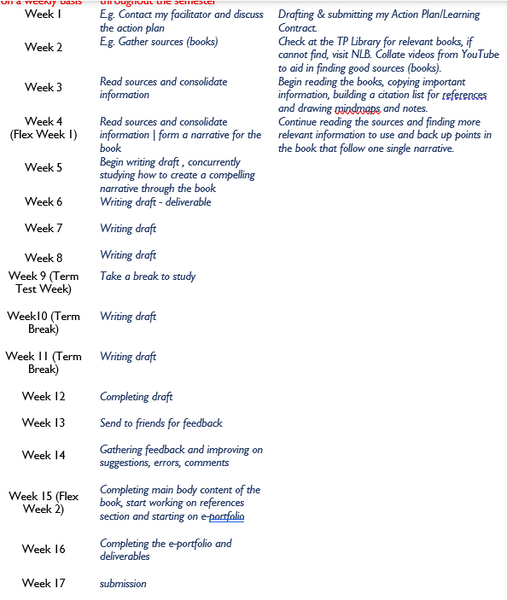

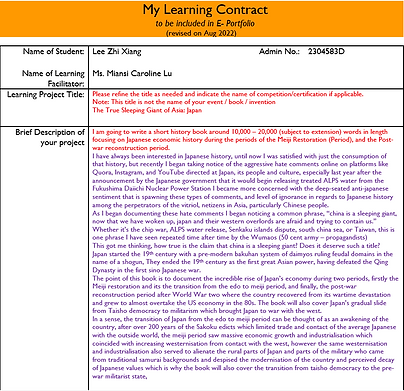



My Library Sources
Pictured are some of the books I used in my research sourced from the Temasek Polytechnic Library. These books were helpful in shaping a narrative which my book could follow.
1. Japanese Industrial History: Technology, Urbanisation and Economic Growth
2. The Sino-Japanese War and the Birth of Japanese Nationalism
3. Japanese Industrialisation: Historical and Cultural Perspectives
In the end, i leveraged more on online sources such as academic journals and authoritative sources to write the book due to the convenience of access. The full list can be accessed via the button below.
